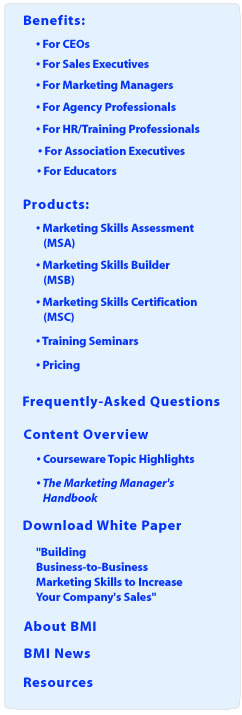



 |
 |
 |
 |

Tuesday Marketing Notes (Number 108—January 15th, 2008)
MAKE SURE YOU CONTINUE TO RECEIVE EACH ISSUE OF TUESDAY MARKETING NOTES—CLICK HERE TO RENEW YOUR FREE SUBSCRIPTION
(NOTE: If you’ve already signed up previously at this link, no need to do so again)
Fixing Marketing Deliverables that Don’t Sell: Putting Creative Effectiveness to Work
By Rick Kean
Why does so much marketing activity fail to “connect” and deliver measurable sales response in the form of sales leads? The sad answer is that their authors and sponsors were impatient and presumptuous: They set about building a fancy house without laying the groundwork, setting cornerstones, and building a solid foundation.
So why do some programs work and others don’t? The problem isn’t a shortage of talent—while there are never enough stars, there are many capable people around. Nor is it lack of effort—just about everybody in our field tries to do great work. It’s not a gap in technology—the tools of the trade are universal today. And the differences are not in the size of the budget—great work is being done on relatively small budgets while mediocre work is often done with fairly large budgets.
Most problems with business-to-business marketing communications can be traced to weak corporate marketing cultures—symptoms of which include poor market and competitor intelligence, convoluted approval processes and, maybe most important of all—having people in charge who don’t know a feature from a benefit. Poor marketing execution is another leading cause of failure in business-to-business marketing programs.
Who’s to Blame?
The skills and competence of both client-side and agency people varies all over the lot. The agency people would maintain that their good work often gets butchered by clients. While those on the client-side often treat the process of marketing execution of the advertising, direct mail, and other marketing projects in their program as a “black box:” A mysterious process to be handled by others and kept at arms-length.
The only explanation is that—as in any other occupation—there are both client and agency people who are poorly trained and don’t know their business as well as they should. Their creative sins seem to fall into two main categories:
• Good source material—poor creative tactics: The basic selling proposition is adequate or even strong, but poor creative tactics make it hard to really believe, hard to understand or even hard to read. The agency creatives have simply violated some of those communications basics that (supposedly) everyone knows;
• Poor source material—poor creative tactics: The client’s selling proposition is either too weak or too poorly supported to justify in the communication. This puts the agency creative people under pressure to fill the void with “creativity.” But this just can’t be done. If they hold to sound creative techniques—which amplify the selling proposition—they just advertise the fact that their client doesn’t have much to offer. So they cover up by creating a diversion—often with creative backflips, a lot of irrelevant borrowed interest and copy that is so general and self-indulgent that it turns off the reader.
Granted, the client deserves much of the blame for initiating—and approving deliverables like these. But strong, competent agencies discourage these practices right at the start; they tell their clients to save their money until they can develop a solid, helpful message.
What Counts is Creative Effectiveness
Much of our problem comes from our worship of creativity as a tonic that is inherently good. In the real world, the creativity served-up is a mixed bag of good and bad. We should stop praising creativity, per se, and concentrate on creative effectiveness. There’s a world of difference.
The business-to-business marketer who gets consistently good work from their agency are those who are more, not less, involved, with the factors that govern creative effectiveness. They are more involved—in an informed and constructive way. They value the creativity of their agency colleagues; they know that, used wisely, this creativity can multiply the impact of a strong selling proposition.
But they have also learned the hard way that creativity is often misused. The have learned it’s wise to serve as a backstop to make sure that agency creativity is being used effectively in service of strong selling propositions.
Getting Creativity to Serve the Goal of Generating Sales Response
We’re told that judging creative effectiveness is an inseparable part of the creative process, and that client-side people aren’t qualified to make that judgment. Baloney. If you were to check the sub-par ads or mailing pieces out there, you’d find they violate the simple, keep-your-eye-on-the-ball basics that any reasonably intelligent person can easily understand, like:
• Have something to say. Offer a reward that is important and helpful to the reader;
• Offer that reward quickly, either in the headline, illustration or the first paragraph. Don’t bury it;
• Back up the promised reward with specific, believable facts, not generalities;
• Make it easy and interesting to read, and develop the selling proposition in a logical way
Talk in terms of the reader’s business, not yours. Talk person-to-person in simple language. Don’t allow the “art” to get in the way of the message.
Really now, you don’t have to be a creative whiz to understand that. You don’t have to work for an agency. You don’t even have to be in marketing. These principles make obvious good sense to most product and general managers, even engineers and financial people. When you make the effort to acquaint them with the basics, good work sails through the company approval line a lot faster.
Of course, it’s far better when the agency is its own backstop, and catches creative violations before they get to the client. But agency creatives do sometimes throw a wild pitch now and then. What’s more, they are also very human, and—although rarely mentioned—have just as much trouble being objective about their own creative efforts as their client does in being objective about the virtues of their products and their company. Both sides need a backstop.
It’s wise and helpful to both sides when the client is well-informed on the basics of how a thing is done, even if they’re not the person doing it. More important, they’ll also be motivated to provide better marketing direction because they see that some of the agency’s misguided creativity is a valiant but hopeless effort to compensate for the lack of a strong, well-supported selling proposition.
Rick Kean (rkean@businessmarketinginstitute.com) is Managing Director of The Business Marketing Institute.
Real Marketing: The Skills You Need for Business-to-Business Marketing Success, a 47-page overview of content covered by the BMI MSA/B/C Training and Certification System




Login![]() Home
Home![]() Free Demo
Free Demo![]() Free Newsletter
Free Newsletter![]() Order Now
Order Now![]() Contact Us
Contact Us
Copyright 2005-2008 Business Marketing Institute, LLC

